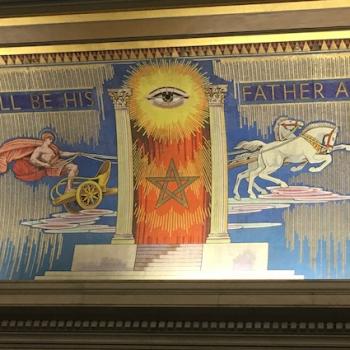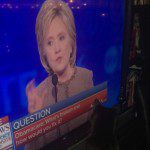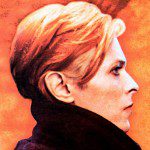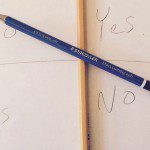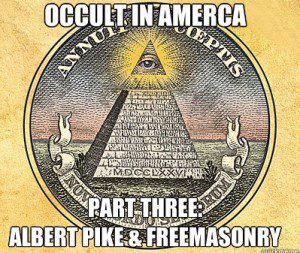 (This post is the third in a series based upon a lecture I began presenting this past Spring. That talk, “Magick and The Occult in America 1820-1952″ surveys a large swath of American History and the occult and magickal practices contained within it. None of this is meant to be the last or only word on the subject, it’s just a look into corners of history I find particularly interesting. The actual lecture has more information than the written versions (and usually more jokes!) but I wanted to present at least some of that talk here on Raise the Horns. -jason)
(This post is the third in a series based upon a lecture I began presenting this past Spring. That talk, “Magick and The Occult in America 1820-1952″ surveys a large swath of American History and the occult and magickal practices contained within it. None of this is meant to be the last or only word on the subject, it’s just a look into corners of history I find particularly interesting. The actual lecture has more information than the written versions (and usually more jokes!) but I wanted to present at least some of that talk here on Raise the Horns. -jason)
There are no statues of any Confederate leaders in Washington DC, with one exception. That one exception is a statue of Albert Pike one of the most influential American Freemasons in history and a onetime Confederate general. No less of an authority than Arthur Edward Waite once wrote that Pike “had a mind to transform the ancient accepted Scottish right into a seminary of occult study.” (1) Pike was not only one of the most transformative Masons in the history of the United States, he was also one of the most influential American occultists of the 19th century.
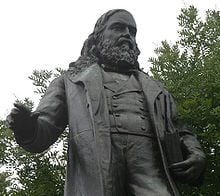 When I talk to my friends about Freemasonry the question of whether or not the Freemasons are an occult organization often comes up. I am of the opinion that the amount of occult material in modern Masonry depends on the perspective of the practitioner. If you are looking for an occult experience, you can find it in Freemasonry. If you are simply looking for a fraternal order you can also find that within Freemasonry, and there are many devout Christians who are Freemasons who are not actively looking for any sort of occult meaning in “The Craft.” To put it simply, it’s there if you want it, and if you don’t want it, that’s fine too.
When I talk to my friends about Freemasonry the question of whether or not the Freemasons are an occult organization often comes up. I am of the opinion that the amount of occult material in modern Masonry depends on the perspective of the practitioner. If you are looking for an occult experience, you can find it in Freemasonry. If you are simply looking for a fraternal order you can also find that within Freemasonry, and there are many devout Christians who are Freemasons who are not actively looking for any sort of occult meaning in “The Craft.” To put it simply, it’s there if you want it, and if you don’t want it, that’s fine too.
For most of its public history occult images have been associated with Freemasonry. Over the centuries various “rites” and degrees have been built around occult and (ancient) pagan ideas. Even during the relatively quiet 18th Century (well, quiet by occult standards) several esoteric Christian rites competed amongst each other in various Masonic Halls. (2) Pike’s rituals amplified the occult imagery in his Reformed Scottish Rite and he provided the keys to understanding it. Up until the early 1970’s his book Morals and Dogma of The Ancient and Accepted Scottish Rite of Freemasonry was given to anyone who obtained the 14th Degree within that system.
While his ideas are widely known amongst occult and Masonic historians there are many conflicting stories about his life. Some have claimed that he attended Harvard while many modern scholars dismiss the idea. In addition to fighting for the Confederacy in the Civil War he was said to have had many manly adventures in Missouri and Arkansas and some claim that he helped to establish the Ku Klux Klan. What is known is that in 1859 he was elected Sovereign Grand Commander of the Southern Jurisdiction of the Scottish Rite. It was a post that he would hold until his death in 1891. It was upon his election as Sovereign Grand Commander that he began rewriting the rituals of the Scottish Rite, infusing them with a large degree of occult philosophy and ideas.
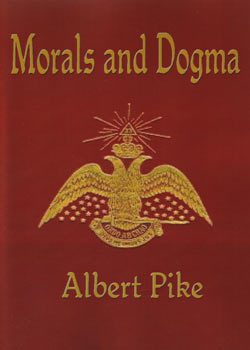 When I first began gathering information on Albert Pike I decided to start with a Google image search because I was curious about what he looked like. One of the first images I came across featured the faces of Pike, Karl Marx, Mao Zedong, Joseph Stalin, and finally Barack Obama (of course). The degree of loony respect for Pike took me by surprise. Apparently there are crazy Christian groups who think that Pike’s influence on world affairs remains strong enough that he can be looked at as a junior Antichrist. Though I’m not the biggest Pike fan, I think their fears are unwarranted, but I understand where that fear comes from.
When I first began gathering information on Albert Pike I decided to start with a Google image search because I was curious about what he looked like. One of the first images I came across featured the faces of Pike, Karl Marx, Mao Zedong, Joseph Stalin, and finally Barack Obama (of course). The degree of loony respect for Pike took me by surprise. Apparently there are crazy Christian groups who think that Pike’s influence on world affairs remains strong enough that he can be looked at as a junior Antichrist. Though I’m not the biggest Pike fan, I think their fears are unwarranted, but I understand where that fear comes from.
Like many in the late 19th century Albert Pike saw Lucifer as a figure of redemption and a flattering portrait of the Light-bearer is painted in Morals and Dogma. None of Pike’s writings about Lucifer were particularly inspired or even original. Nearly all of the ideas (and even some of the words) Pike shared about Lucifer were stolen/borrowed from French occultist Eliphas Levi. (3) It’s Pike’s writings about Lucifer that provoke the crazy in many Fundamentalist Christians. I don’t think anything in Pike is all that outrageous, but I (probably like you) understand the context. The people who write Chick Tracts don’t.
Some of Pike’s writings on Lucifer don’t seem all that different from what would wind up in Aradia just a few decades later. Levi, Pike, and all of those Italian Witches certainly seemed to have a better understanding of “Lucifer” than most of their Christian contemporaries. A quick look at a few quotes from Morals and Dogma at least explains why Pike is looked at by many as a godless, Satanic, communist on par with Barack Obama.
“ Lucifer, the Light-bearer! Strange and mysterious name to give the Spirit of Darkness! Lucifer, the Son of the Morning! Is it he who bears the Light, and with its splendors intolerable blinds feeble, sensual, or selfless souls? Doubt it not!” From Morals and Dogma
In a different passage Pike (again “borrowed” from Levi) continues on, linking Satan to the (mythological) god Pan and other mystical forces:
“the true name of Satan, the colonists say, is that of Yahweh reserved; for Satan is not a black God, but the negation of God. The devil is the personification atheism or idolatry. For the initiates this is not a person, but for us, created for good, but which may serve or evil. Is the instrument of liberty or freedom will period they represent this force, which presides over the physical generation, under the mythological and warned form of God and, thence came as he goat of the Sabbath, brother of the aged circuit, and the light bearer, or philosopher, of which the poets has made the false Lucifer of the legend.”
In addition to writing about Lucifer as the Light-bearer, Pike also added sexual imagery to the Masonic tools of the Compass and the Square. Personally I never found either tool remotely sexual or phallus like, but that didn’t stop Pike. In Morals and Dogma he reflected on the sexual nature of the two most well-known Masonic symbols:
“ To us, creation is mechanism: to the agents it was generation… from this idea of generation came the reverence everywhere paid to the image of generated power, which formed the star rose of the Gnostics, and a philosophical cross of the Masons. As the procreative and generative agents, the heavens and the sun have always been regarded as male; as the generators that fructify the earth and causes it to reproduce. The Compass therefore, is the hermetic symbol of the creative deity, and the square of the productive earth or universe.”
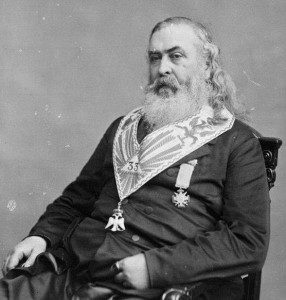 While I’ve never come across anyone claiming that Pike was a “Pagan” (in either the classic or modern sense of the word) his early poetry had a great degree of sympathy for the deities of antiquity. Like many occultists of the time, Pike’s personal cosmology probably included whatever was expedient to him at the time. Hymns to the Gods was an early (and long) poem first published when Pike was 23, it was later part of a larger collected work entitled Hymns to the Gods and Other Poems published in 1872. Later additions of Other Poems were edited by his daughter and appeared after his death.
While I’ve never come across anyone claiming that Pike was a “Pagan” (in either the classic or modern sense of the word) his early poetry had a great degree of sympathy for the deities of antiquity. Like many occultists of the time, Pike’s personal cosmology probably included whatever was expedient to him at the time. Hymns to the Gods was an early (and long) poem first published when Pike was 23, it was later part of a larger collected work entitled Hymns to the Gods and Other Poems published in 1872. Later additions of Other Poems were edited by his daughter and appeared after his death.
Surprisingly, some of Pike’s Hymns to the Gods is decent poetry, I especially like this verse dedicated to Dionusos:
Oh, thou who lovest pleasure! at whose heart
Wine’s warmth is always felt; who takest part
In all mad, wanton mirth; who in the dance
Of merry maidens joinest, where the glance
Of bright black eyes, and twinkling of white feet,
Of lovely girls delight thee, when they meet
Under the summer moon!—Giver of peace
To all careworn, sad men!—whose smiles make cease
The piercing pains of grief; for whom young maids
Weave ivy garlands, and in pleasant glades
Hang up thine image, and, with happy looks,
Go dancing round, while shepherds, with long crooks,
Join the glad company, and glide about
With merry laugh and many a hearty shout,
Staining with rich dark grapes each little cheek
That most they love; and then, with sudden freak,
Seizing the willing hand, and dancing on
About the green mound:—Oh, thou merry son
Of supreme JOVE!
Wherever thou dost rove,
Among the thick vines, come, ere day is done,
And let us too thy sunny influence prove.
Classical religion continued its hold on Pike throughout his life. Morals and Dogma contains many passages reflecting upon ancient deities.
Albert Pike will never make my list of “favorite occultists” (his racism was beyond unforgivable) but he was influential in spreading European occult philosophies and ideas within the United States. He brought the works of Levi to a large audience, and helped popularize the Kabbalah. Pike was most certainly a flawed individual, but he was also an important one.
There are other bits in this series, including a write up of The Long Lost Friend and Joseph Smith of the Church of Latter Day Saints. While not originally a part of this series the lecture included material on Johnny Appleseed who I have written about previously. It also included a section on The Church of Aphrodite which Aidan Kelly wrote about last year.
_________
1. Ritual America: Secret Brotherhoods and Their Influence on American Society by Adam Parfrey and Craig Heimbichner published by Feral House and released in 2012. Despite its rather sinister sounding title Ritual America is a mostly sober account of fraternal orders in the United States. In addition to the enlightening text, it’s full of gorgeous, rare, and amazing photos. I love this book. The Waite quote comes from page 72. This is one of the books that sparked my interest in the Magick and the Occult project last summer and was my first introduction to Pike beyond a stray few sentences.
2. Solomon’s Secret Arts: The Occult in the Age of Enlightenment by Paul Kleber Monod published by Yale University Press and released in May of 2013 is the first comprehensive history of the occult I’ve come across dealing specifically with the Enlightenment period in Great Britain. Monod writes extensively about Freemasonry in Solomon’s Secret Arts and provides numerous examples of Masonic degrees and rituals that might be considered occult. Start reading on page 254 and then just go through the end of the book. Heck, just read the book if you have an interest in this stuff.
3. The idea that Pike borrowed/stole from Levi comes from Parfrey and Heimbichner.
Though I haven’t cited them, I did read Mark Stavish‘s Freemasonry: Rituals, Symbols, and History of the Secret Society (Llewellyn, 2007). much like Ritual America I was surprised by the non-sensationalist approach. I’ve probably read the section on Masonry in Triumph of the Moon by Ronald Hutton (Oxford University Press, 1999) several dozen times, I’m sure it’s influenced by opinions on Masonry.









